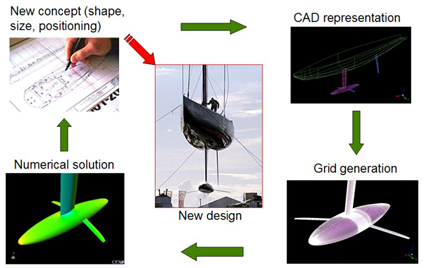Math for Sailing
In 2001 Ernesto Bertarelli, the leader of the Alinghi team, contacted
the Ecole Polytechnique Fédérale de Lausanne (EPFL) asking for
a scientific advisor for the critical parts of the project, namely the materials
for the hull and the fluid dynamics for the design of the boat. The EPFL research
groups cooperated with the design team of Alinghi in order to help them
design the optimal boat and test its performance. We will describe
the contributions of the math group to the optimization of the design of
Alinghi using advanced computational fluid dynamics (CFD) techniques.
This design could not have been completed were if not for the advances in
mathematics and computational algorithms created for this specific project.
 |
The design process can be represented as a loop which involves sailing experience
and mathematical skills. New concepts are tested and improved by means of numerical
simulations, to get the best compromise between performance and the constraints
imposed by the racing rules. Enlarge.
(Image courtesy of CMCS (Chair of Modeling and Scientific Computing-EPFL-Lausanne))
|
|
|
An America’s Cup yacht is a very sophisticated system that should work
optimally in a wide range of sailing conditions. The different components (above
and below the water surface) of a sailing yacht interact in several complicated
ways, and the design of the yacht must consider this complexity as a whole.
The development of suitable experimental
and numerical tools, which can describe the system as accurately as possible
is required in order to achieve an optimal configuration.
The goal in creating
a sailboat design for competition is to find shapes of the boat, its appendages
(like the keel), the bulb and the winglets, and its sails so that the sailboat
moves with greatest speed and is more easily maneuverable in a variety of wind
and wave conditions. Historically these designs were created by master craftsmen
who made their choices based on experience and agreed on rules of thumb. In
the 1990’s engineers started employing “simple” models
to estimate basic quantities of physical relevance (such as the drag on the
hull) prior to construction of the boat.
Recent advances allowed mathematicians to work with boat designers and sailors
to create more realistic mathematical models for how a sailboat handles in
different marine conditions. The solutions to these models are difficult to
find, even numerically, for three reasons. First, the equations are not standard
(they involve the coupling of different submodels) and a complete theory
that guarantees the existence and uniqueness of the solutions is not yet
available. Second,
the equations are so complicated that finding accurate solutions numerically,
even on a modern supercomputer, can take a long time. Third, solutions should
simultaneously optimize boat performance in many different conditions (wind
speed, boat direction relative to wind direction, wave height and direction,
etc).
Mathematicians were essential because they set up the theoretical basis for
solving the model equations, developed new numerical algorithms to solve the
model equations more quickly (so that the equations modeling a given design
could be solved under many different marine conditions), and determined
strategies for deciding which of two different designs give generally better
results over a variety of weather conditions.



